
Alec Grieve (1864-1933) was a Dundee artist best known for his symbolist and landscape paintings. He was born in Dundee on 13 October 1864.

Alec Grieve (1864-1933) was a Dundee artist best known for his symbolist and landscape paintings. He was born in Dundee on 13 October 1864.
He began studying art at Dundee School of Art in the High School of Dundee and first exhibited his work with the Dundee Art Club in 1888. Befriending the artists John Duncan and Stewart Carmichael, he moved to London at around the same time as them, working both as a commercial artist for various publishers and exhibiting at the Royal Academy of Arts. [1] Around 1889 he went on to further study at the Académie Colarossi in Paris. [2] Grieve returned to Dundee in 1890, showing at the Dundee Fine Art Exhibition that year and joining the Graphic Arts Association soon after, becoming one of the most prolific contributors to the Association's annual exhibitions [2]
By 1893 he had taken a studio in the former Theatre Royal building at 15 Castle Street in Dundee. Several Dundee artists had come together here to occupy the city’s first shared artists’ studio, including Stewart Carmichael, Max Cowper and the sculptor Margaret Suttie, who exhibited a bust of Grieve at the 1895 Dundee Fine Art Exhibition. [3] In 1893 Grieve held a solo exhibition from his Castle Street studio, at which landscape paintings were the most acclaimed.
Grieve's early landscape paintings were particularly inspired by the ‘Nocturnes’ of Whistler. Their influence is apparent in many of Grieve's early exhibits at the Graphic Art Association – Nightfall (1894), Nocturne in Grey – the Tay Ferries (1895), Nocturne – A Moonlight Sonata (1896) and Nocturne – Moonlight on the Tay (1897). But Grieve’s colour scheme gradually brightened, as can clearly be seen by comparing his two views of Pont du Cheval, Bruges in Dundee's permanent collection. [4]
Grieve painted symbolist or religious works such as Death and the Miser (1893), Sancta Spirita (1897) and The Longing of Eve (1898) that sought to express his intellectual ideals. The critics largely ignored these in favour of his landscapes, but when they did receive attention, opinion was decidedly mixed. The Advertiser referred to Grieve’s “dangerous quality of imagination” and “original ideas”. [5] A writer in the Evening Telegraph found The Longing of Eve “simply horrible”. [6]
More serious attention was paid in 1897, when Grieve held a second solo exhibition in Thomas Murray’s gallery in Nethergate. After this show, critics reacted more positively to his work. Finis (1898) was widely praised, and after its debut at the Graphic Arts Association exhibition was shown at the Glasgow Institute and Royal Scottish Academy.
Grieve was also a firm believer in socialism. During his time in London he became a close friend of Keir Hardie, and was the cartoonist for many years on Hardie’s periodical the Labour Leader. [7] He was a member of the Independent Labour Party and the Dundee Central Workers Committee and often wrote about the role of art in the labour movement.
Grieve’s figurative work had always shown a keen sympathy for the working class. In 1894, for example, he created a set of twelve etchings under the title The Blind at Work, showing scenes of life in the Dundee Blind Institution. [7]
Grieve’s many rural landscape paintings did not generally reveal his political sympathies, a notable exception being the 1903 painting The Ploughman and the Crows (now in Perth Museum & Art Gallery). It was exhibited at the Graphic Arts Association exhibition that year and later at the Paris Salon, where it was hung on the line and attracted considerable attention for its political symbolism – the crows as capitalists living off the fruits of the working man’s toil. [8]
Grieve moved to Tayport after his marriage in 1897, taking a studio at West Lights. In 1904 he and Frank Laing became the founders of the Tayport Artists' Circle, an exhibiting body of artists hoping to emulate the commercial success of other artists' colonies such as at Newlyn. Their first exhibition was held in Tayport in 1905, with three exhibitions following in Dundee in 1905-07 and one in Edinburgh in 1907. [9]
Grieve died in 1933 just a few days after the opening of his group exhibition at the Victoria Galleries with Stewart Carmichael and John Maclauchlan Milne [10] (the three had previously shown together in the Dundee Art Society rooms in 1920). A memorial exhibition of Grieve’s work was held two years later, at which it was noted that his work had “steadily advanced from a sort of poetical obscurity to notable brilliancy of colour” [11]
A lithograph portrait of Grieve by Stewart Carmichael is in the collections of Dundee Art Galleries & Museums.
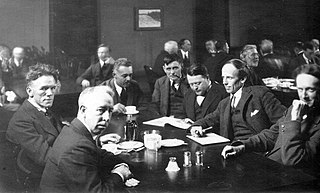
The Group of Seven, once known as the Algonquin School, was a group of Canadian landscape painters from 1920 to 1933, with "a like vision". It originally consisted of Franklin Carmichael (1890–1945), Lawren Harris (1885–1970), A. Y. Jackson (1882–1974), Frank Johnston (1888–1949), Arthur Lismer (1885–1969), J. E. H. MacDonald (1873–1932), and Frederick Varley (1881–1969). A. J. Casson (1898–1992) was invited to join in 1926, Edwin Holgate (1892–1977) became a member in 1930, and Lionel LeMoine FitzGerald (1890–1956) joined in 1932.

The Celtic Revival is a variety of movements and trends in the 19th, 20th and 21st centuries that see a renewed interest in aspects of Celtic culture. Artists and writers drew on the traditions of Gaelic literature, Welsh-language literature, and Celtic art—what historians call insular art. Although the revival was complex and multifaceted, occurring across many fields and in various countries in Northwest Europe, its best known incarnation is probably the Irish Literary Revival. Irish writers including William Butler Yeats, Lady Gregory, "Æ" Russell, Edward Martyn, Alice Milligan and Edward Plunkett stimulated a new appreciation of traditional Irish literature and Irish poetry in the late 19th and early 20th century.

Lawren Stewart Harris LL. D. was a Canadian painter, best known as a leading member of the Group of Seven. He played a key role as a catalyst in Canadian art and as a visionary in Canadian landscape art.

Lilla Cabot Perry was an American artist who worked in the American Impressionist style, rendering portraits and landscapes in the free form manner of her mentor, Claude Monet. Perry was an early advocate of the French Impressionist style and contributed to its reception in the United States. Perry's early work was shaped by her exposure to the Boston School of artists and her travels in Europe and Japan. She was also greatly influenced by Ralph Waldo Emerson's philosophies and her friendship with Camille Pissarro. Although it was not until the age of thirty-six that Perry received formal training, her work with artists of the Impressionist, Realist, Symbolist, and German Social Realist movements greatly affected the style of her oeuvre.

Sir George Clausen was a British artist working in oil and watercolour, etching, mezzotint, drypoint and occasionally lithographs. He was knighted in 1927.
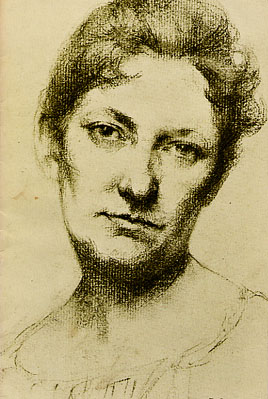
Minerva Josephine Chapman (1858–1947) was an American painter. She was known for her work in miniature portraiture, landscape, and still life.
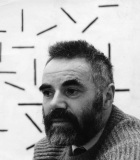
Edwin John Victor Pasmore, CH, CBE was a British artist. He pioneered the development of abstract art in Britain in the 1940s and 1950s.
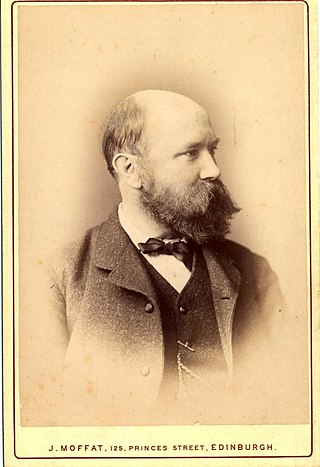
William McTaggart was a Scottish landscape and marine painter who was influenced by Impressionism.
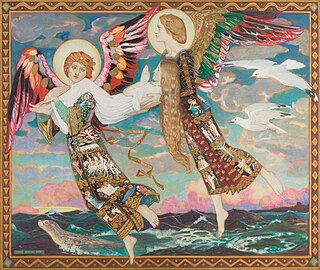
John Duncan (1866–1945) was a Scottish Symbolist painter. Much of his work, apart from portraits, depicted Arthurian legends, Celtic folklore, and other mythological subjects.

Duncan of Jordanstone College of Art & Design (DJCAD) is part of the University of Dundee in Dundee, Scotland. It is ranked as one of the top schools of art and design in the United Kingdom.

Dennis Miller Bunker was an American painter and innovator of American Impressionism. His mature works include both brightly colored landscape paintings and dark, finely drawn portraits and figures. One of the major American painters of the late 19th century, and a friend of many prominent artists of the era, Bunker died from meningitis at the age of 29.
Joseph Johnston Lee (1876–1949) was a Scottish journalist, artist and poet, who chronicled life in the trenches and as a prisoner of war during World War I. He is also remembered for his dispute with then poet laureate Robert Bridges over the literary value of Robert Burns' work. He has been described as "Scotland's 'Forgotten' War Poet", as well as "Dundee's forgotten war poet."
William Bradley Lamond RBA (1857–1924) was a Scottish painter, born at Newtyle, Angus. He had no formal art training and worked for the Caledonian Railway company for many years. He initially specialised in portraits and later worked on landscapes which have been described as "vigorous impressionistic scenes in oil – with a strong use of colour". He was elected a member of the Royal Society of British Artists in 1906, and exhibited at the Royal Academy, Royal Scottish Academy and Glasgow Institute of the Fine Arts.

David Foggie RSA, was a Scottish painter, born to parents James and Margaret Foggie.

Menci Clement Crnčić was a Croatian painter, printmaker, teacher and museum director. He studied painting and drawing in Vienna and Munich, and trained in graphic arts in Vienna, studying etching and engraving. He was the first artist in the Croatian graphic tradition to abandon a strictly linear style and use tonal variation to create contrasting areas of light and shade.

Clara Isabella Harris was a Canadian artist. She worked in the media of painting, watercolours, sculpture, sketching, and wood carving.
The Abertay Historical Society (AHS) is a historical society based in Dundee, Scotland. It aims to promote interest in history, with a special focus on the history of Perthshire, Angus and Fife. The AHS runs a regular programme of public lectures on historical topics and also organises special events. The Society also publishes books, usually producing at least one publication per year.
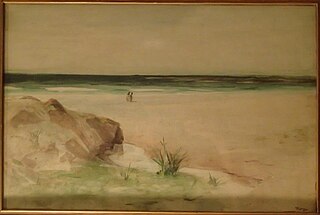
Frank Laing was a Scottish painter and etcher. He is best known for his watercolours and etchings of European landscapes and architectural subjects. Born in Tayport, Fife, Laing lived and worked throughout Europe, producing a portfolio of notable work from Spain, Paris, Chartres, Antwerp and Venice before returning to Scotland.
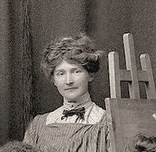
Grace Ellen Butler was a New Zealand artist.
Stewart Carmichael was a Scottish painter known for his Celtic Revival, Symbolist and historical scenes. He has been described by the poet and academic Alan Riach as "one of the first truly Modernist Scottish artists, a painter of real stature".